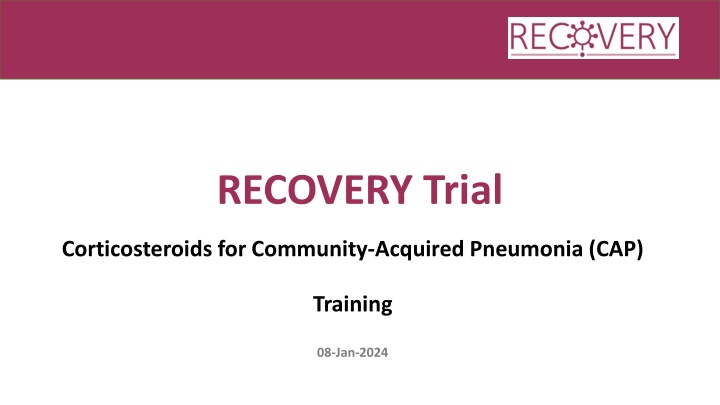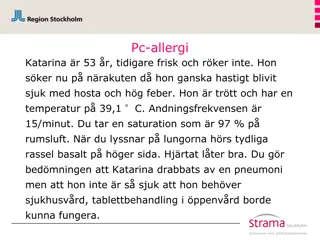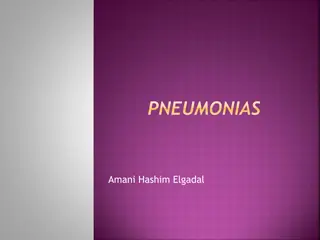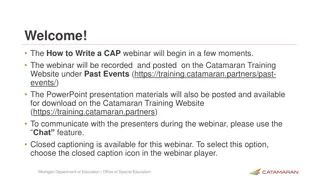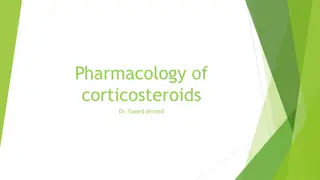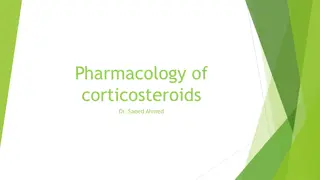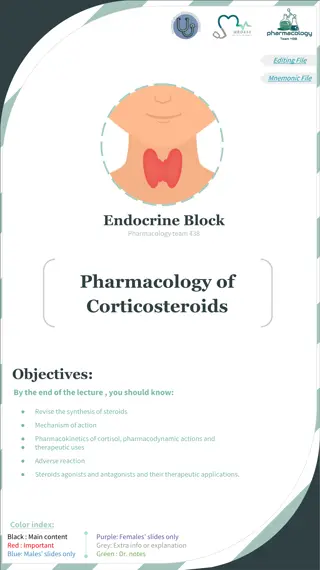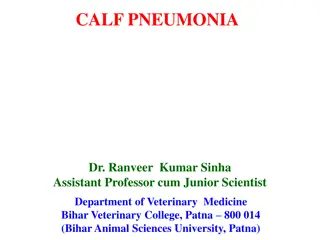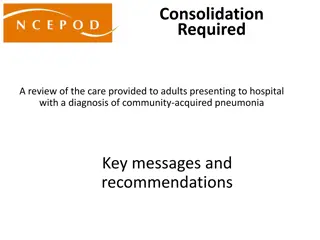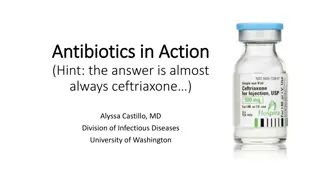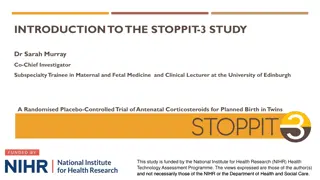RECOVERY Trial: Corticosteroids for Community-Acquired Pneumonia (CAP) - Overview and Eligibility Criteria
Community-Acquired Pneumonia (CAP) is a common reason for hospitalization globally, with estimated annual fatalities of approximately 2.5 million. The RECOVERY Trial is investigating the use of corticosteroids in patients with CAP suspected or confirmed to be of bacterial origin. Eligibility criteria include hospitalization, pneumonia syndrome with typical symptoms and objective evidence of lung disease, confirmed viral infections, and exclusion of alternative causes. Corticosteroids like dexamethasone have shown mortality reduction benefits in hypoxic COVID-19 patients and severe Pneumocystis pneumonia cases, highlighting potential advantages in CAP management.
Download Presentation

Please find below an Image/Link to download the presentation.
The content on the website is provided AS IS for your information and personal use only. It may not be sold, licensed, or shared on other websites without obtaining consent from the author.If you encounter any issues during the download, it is possible that the publisher has removed the file from their server.
You are allowed to download the files provided on this website for personal or commercial use, subject to the condition that they are used lawfully. All files are the property of their respective owners.
The content on the website is provided AS IS for your information and personal use only. It may not be sold, licensed, or shared on other websites without obtaining consent from the author.
E N D
Presentation Transcript
RECOVERY Trial Corticosteroids for Community-Acquired Pneumonia (CAP) Training 08-Jan-2024
Community-acquired pneumonia In a non-pandemic context, CAP is usually caused by bacteria from the upper respiratory tract The causative pathogen is usually not identified, so diagnosis is based on a typical symptoms and radiology, and treatment is with empirical antibiotics and supportive care The RECOVERY CAP comparison is recruiting these patients, with CAP related to suspected or confirmed bacterial infection CAP is one of the commonest reasons for acute hospital admission worldwide, estimated to kill ~2,500,000 people/year Viral pneumonia caused by SARS-CoV-2 and influenza have distinct pathologies and treatments, and can be diagnosed readily by throat swab PCR, so these are treated as separate categories of pneumonia in RECOVERY Case courtesy of Jeremy Jones, Radiopaedia.org
RECOVERY Eligibility 1. Hospitalised 2. Pneumonia syndrome, e.g. a. Typical symptoms of a new respiratory tract infection (cough, shortness of breath, fever, etc); and b. Objective evidence of acute lung disease (e.g. X-ray/CT/US changes, hypoxia, or clinical exam); and c. Alternative causes considered unlikely or excluded (e.g. heart failure) However, the diagnosis is a clinical one in the opinion of the managing doctor (these criteria are a guide) 3. One of the following diagnoses: a. Confirmed SARS-CoV-2 infection b. Confirmed influenza A or B infection c. Community-acquired pneumonia with planned antibiotics (without suspected COVID-19/flu/PCP/TB) 4. No medical history that might put the patient at risk if they were to participate 5. Attending clinician does not believe a specific trial treatment is indicated or contra-indicated
CAP in RECOVERY - clarifications Patients are ineligible if they have suspected or confirmed: SARS-COV-2 infection Influenza infection Pneumocystis jirovecii pneumonia ( PCP or PJP ) Active pulmonary tuberculosis Testing for these pathogens is not required for trial purposes (only if part of standard care) Detection of viruses other than those above is not an exclusion (e.g. RSV, adenovirus, rhinovirus, etc.) Community-acquired can be defined as in usual practice, but implies: Pneumonia was present on admission No recent inpatient stay in hospital or a healthcare facility (e.g. in the 10 days before admission)
Corticosteroids for CAP Dexamethasone 6mg once daily reduces mortality in hypoxic COVID-19 patients by around one fifth1 Corticosteroids are also beneficial in severe PCP2 Despite similarities with COVID-19, lung involvement is typically more focal in CAP, with less severe hypoxia, and different patterns of immune activation3 CAP is also a more heterogeneous syndrome than COVID-19, caused by a variety of pathogens Do corticosteroids reduce mortality in patients hospitalised with CAP? 1 RECOVERY Collaborative Group. N Engl J Med. 2021 PMID32678530 2 Ewald H, et al. Cochrane Database Syst Rev. 2015 PMID25835432 3 Ib ez-Prada ED, et alRespir Res. 2023 PMID: 36814234
Corticosteroids for CAP Saleem N, et al. Chest. 2023. PMID36087797
Corticosteroids for CAP Lower risk of death with steroids in 2023 CAPE COD trial of ICU patients (25/400 v 47/395 died)1 However, no favourable result in ICU patients in 2022 ESCAPe trial (47/286 v 50/277 died)2 Corticosteroids reduce time to discharge in CAP, but this may be a direct effect of fever/CRP reduction, rather than representing an improvement in outcomes3 (and some evidence that readmissions may be higher in those allocated corticosteroids4) We need more randomised evidence from a wide range of patients to inform treatment of CAP 1Dequin P, et al. N Engl J Med. 2023 PMID369427891 3Joseph L, et al. Lancet 2011. PMID21907856 2Meduri G, et al. Intensive Care Med. 2022. PMID35723686 4Saleem N, et al. Chest. 2023. PMID36087797
Current RECOVERY design Community-acquired pneumonia (CAP) corticosteroid comparison COVID-19 high dose corticosteroid comparison (patients on NIV or IMV) Sotrovimab comparison HOSPITALISED PATIENTS WITH PNEUMONIA Usual care without corticosteroids Usual care (standard dose corticosteroids) Usual care without sotrovimab M J E High dose dexamethasone or or or Dexamethasone Sotrovimab Patients with CAP (without suspected SARS-CoV-2/influenza/PCP/TB) Patients with confirmed SARS-CoV-2 ANALYSIS Outcomes at 28 days and 6 months Mortality Time to discharge alive Progression to ventilation or death R Baseline data collected, suitability determined 1:1 randomisation in each suitable comparison Influenza corticosteroid comparison (patients with hypoxia) Baloxavir comparison Oseltamivir comparison Usual care without baloxavir Usual care without oseltamivir Usual care without corticosteroids G H I or or or Baloxavir Oseltamivir Dexamethasone Patients with confirmed INFLUENZA
Current RECOVERY design Community-acquired pneumonia (CAP) corticosteroid comparison COVID-19 high dose corticosteroid comparison (patients on NIV or IMV) Sotrovimab comparison HOSPITALISED PATIENTS WITH PNEUMONIA Usual care without corticosteroids Usual care (standard dose corticosteroids) Usual care without sotrovimab M J E High dose dexamethasone or or or Dexamethasone Sotrovimab Patients with CAP (without suspected SARS-CoV-2/influenza/PCP/TB) Patients with confirmed SARS-CoV-2 ANALYSIS Outcomes at 28 days and 6 months Mortality Time to discharge alive Progression to ventilation or death R Baseline data collected, suitability determined 1:1 randomisation in each suitable comparison Influenza corticosteroid comparison (patients with hypoxia) Baloxavir comparison Oseltamivir comparison Usual care without baloxavir Usual care without oseltamivir Usual care without corticosteroids G H I or or or Baloxavir Oseltamivir Dexamethasone Patients with confirmed INFLUENZA
CAP Corticosteroid comparison Open to adults 18 years No requirement for hypoxia (unlike influenza corticosteroid comparison) Pregnant & breastfeeding women are eligible (but use prednisolone/hydrocortisone instead of dexamethasone see protocol for dosing) Patients with liver or renal failure are eligible Patients are not eligible if their attending doctor considers systemic corticosteroids to be indicated or contraindicated for any reason If, after randomisation, corticosteroids become indicated in a patient allocated usual care these should be given (this should only be happening because of a change in clinical condition)
CAP Corticosteroid comparison Dexamethasone is a CYP3A4 substrate, so there is a risk of increased exposure and side effects if given alongside potent CYP3A4 inhibitors, e.g. Clarithromycin/erythromycin (but not azithromycin) Ritonavir/cobicistat Azole antifungals Consider whether a potent CYP3A4 inhibitor could safely be suspended/replaced, or if increased monitoring for steroid side effects is needed If potent CYP3A4 inhibitor cannot be avoided then it may not be appropriate to enrol the patient in the corticosteroid comparison, but this is not prohibited by the protocol, as management should be based on an assessment of individual risks/benefits
CAP Corticosteroid comparison Dexamethasone 6mg once daily, oral/nasogastric or iv Treat for 10 days or until discharged, whichever is sooner No baseline or follow-up samples Important side effects of corticosteroids should be considered and anticipated as in normal practice, e.g. Risk of hyperglycaemia (consider need for increased monitoring) Peptic ulceration (consider need for gastroprotection if high risk) Infection (especially if other reasons for immunosuppression) Psychiatric reactions Fluid retention Risk of adrenal insufficiency with sudden withdrawal in some patients, e.g. significant previous corticosteroid use, or other reasons for adrenal insufficiency (consider gradual withdrawal following normal practice)
Summary - CAP CAP is a major cause of hospital admission and death worldwide If corticosteroids reduce the risk of death even moderately (e.g. a 10-20%) it could save tens or hundreds of thousands of lives To identify or rule out a worthwhile benefit of steroids will require far more patients to be randomised than in previous trials Please consider RECOVERY for as many of your patients as possible
